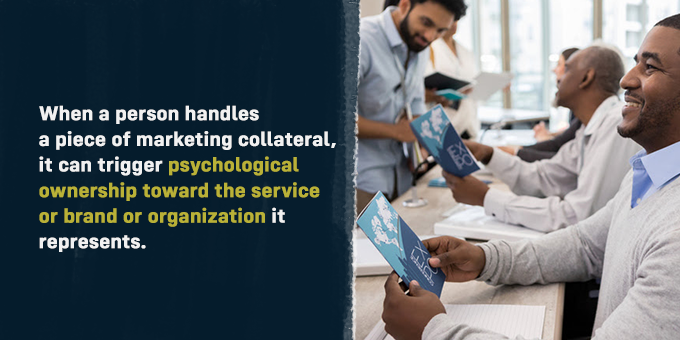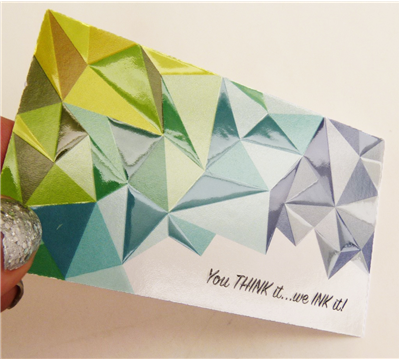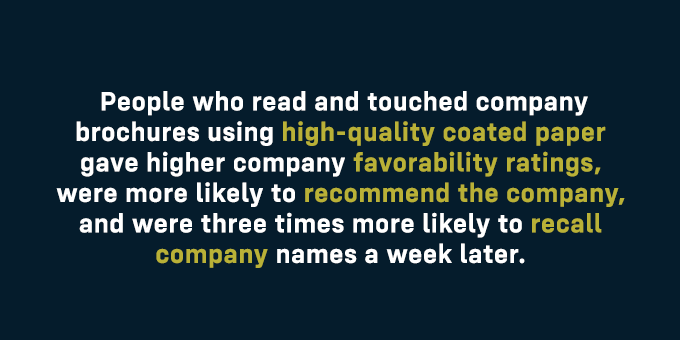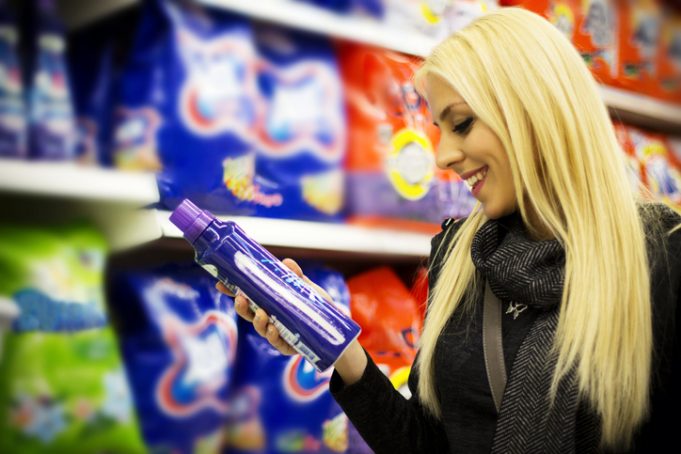
When it comes to your marketing collateral, are you doing enough to engage people’s sense of touch? The research on sensory marketing says it’s more than a good idea. Evidence suggests it can be downright pivotal in generating results.

Joann Peck
Just ask Joann Peck. She probably understands the importance of touch on consumer behavior as well as anyone. An associate professor of marketing at the Wisconsin School of Business, much of her research over the past 20 years has been in sensory marketing, or haptic marketing, more specifically.
Derived from Greek, the word haptic refers to the ability to touch, feel or grasp something.
Peck says when she first started researching touch and its role in marketing, there was essentially nothing in the existing literature.
“But we now know,” says Peck, “that touch can play a huge role in shaping how people view brands, organizations, products, and services—and in how they make purchasing decisions.”
For example, the experience people have when they hold and feel your marketing collateral is likely much more important than we realize. It can initiate an emotional connection, create lasting impressions, and persuade people to choose you, explains Peck.
So how much thought are you putting into the power of touch when it comes to your marketing collateral and other branded print material?
Before you answer that, let’s dive into some of that evidence. Consider these five compelling insights that Peck and others have unearthed in their research on the power and influence of touch.

1. People Like to Touch Just for the Sake of Touching—Some Even Crave It
For many years, says Peck, it was just assumed that touch in consumer behavior was relevant only when it could directly provide information on product attributes.
Examples of this would include people touching a product like tissue, apparel, or fruit to evaluate it and use that information in their buying decisions. That seems straightforward enough.
However, in the Journal of Marketing and the Journal of Consumer Research, Peck and fellow researchers have revealed something less obvious but profoundly important for marketers: The act itself of touching has the potential to influence people’s views and behaviors.
In other words, engaging the sense of touch can play a role even when people can’t derive product information directly from touching.
Peck says for some people touch is extremely important. Dubbing them “high touchers,” she says these are the consumers who are especially likely to respond favorably to touch experiences that involve a stimulating texture.

2. Touch Creates Psychological Ownership (And That’s a Good Thing)
In a Journal of Business Research article, Peck and her research partner demonstrated that customers in stores are more likely to buy a product impulsively simply because they touched it.
In fact, she’s found that just touching a product can even increase the amount a person is willing to pay for it.
Why would that be? Peck believes it may have a lot to do with the endowment effect, a concept used in behavioral economics that basically means we place a higher value on something once we take ownership of it.
But there’s more than one kind of ownership.
To understand how the endowment effect can apply to something like print collateral, the idea of psychological ownership is important. According to Peck, psychological ownership is the feeling that something is “mine!”—even when that’s not technically true or even possible.
“Psychological ownership can come about from making an emotional connection to a brand or organization,” says Peck. And she adds that having control of an object can lead to feelings of psychological ownership.
“Just physically touching something is a form of control,” she explains, “and that can increase feelings of ownership.”

That means when a person handles, say, a brochure, the act of touching it can trigger psychological ownership toward the service or brand or organization the brochure represents.
But Peck explains that also means the quality of the touch experience matters.
In other words, things like texture and paper thickness can play a key role in creating psychological ownership—and ultimately in getting a person to take the next step, like making a phone call, a purchase, or a donation.

3. Texture in Print Collateral Can Persuade
Also in that Journal of Consumer Research article noted above, Peck found that texture can influence people’s willingness to give to nonprofits. For example, in one study her research team partnered with a local children’s museum to design a brochure encouraging donations.
One version of the brochure included a soft, fuzzy circle as part of the design. As Peck notes, the touch element wasn’t a product attribute, per se. However, it did fit with the museum’s emphasis on a “hands-on” experience.
Among the results, the study showed that people who had received a brochure with the fuzzy feature were significantly more likely to say they would donate time or money to the organization.
For the same research, Peck and her colleagues had a pamphlet created that asked if people would donate their time or money to a local arboretum.
With the heading of “Get back in touch with nature,” pamphlet fronts were created that included a textured item such as a feather, tree bark, or sandpaper. Other fronts were created with no texture or with textures that did not relate at all to nature-oriented messaging.

Findings showed that participants who received pamphlets with a textured front were much more likely to express an interest in donating time or money.
And if the texture was also directly relevant to trees and/or nature—like tree bark or a feather—the results were even higher.
In another experiment that involved a fictional charity (“Spread the Warmth”), participants read a pamphlet that requested a donation of time or money to a nonprofit focused on providing blankets to people.
Some participants received a pamphlet with a touch element attached to it, a swatch of fleece fabric. Others read the same pamphlet but without the touch element.
The results showed that those who read the pamphlet with the touch element were more likely to express interest in donating time or money.

4. Touching High-Quality Print Materials Creates Positive Impressions
In some ways, this seems pretty intuitive: If you hand a prospective customer a flimsy, black-and-white business card, it’s probably not going to help you create a strong first impression—at least not a favorable one.
But what about a high-quality textured business card?

In a study that Peck has yet to publish, she and her research colleagues found that beautifully textured business cards led to improved customer perceptions of a business—and even increased levels of customer satisfaction of its services.
Similarly, study participants who handled brochures that used higher quality paper gave better service ratings to a bank and a health club.
Peck says there is also evidence suggesting that having what she calls a “touch cue” at the end of a customer interaction can be especially influential in boosting evaluations.
For example, a salesperson could hand that impressive-feeling business card to a prospective customer at the close of a meeting.
Or, a restaurant could present the bill on pleasant-feeling paper or encase it in a beautifully textured paper folder. “This could actually boost customer evaluations,” says Peck.
Note that other research exists which also correlates paper quality with positive company impressions.

For example, in a Sappi North America study led by neuroscientist and New York Times best-selling author Dr. David Eagleman, people who read—and touched—company brochures using high-quality coated paper gave higher company favorability ratings, were more likely to recommend the company, and were three times more likely to recall company names a week later.
This is in comparison with people who read the same information on both low-quality, non-coated paper and on websites via digital tablet screens.

5. The Power of Touch Extends to Packaging and Labeling
But what about product packaging and labeling? Peck says a lot of brands are missing a huge opportunity to differentiate with textured packaging. “I really believe it’s not being used to its full potential.”
If it’s apparent that a product or label has an interesting texture, that in and of itself is going to compel some people to pick it up simply for the experience of it, Peck explains.
In research not yet published, Peck and her colleagues are studying a beverage brand that’s using both textured and untextured labels.
Though field studies have not been completed, early indications suggest that more people will be drawn to the textured labeling.
In fact, Peck predicts that people will be more likely to purchase the textured version, especially if none of the competitors are doing anything like that. “They’ll also be willing to pay more for it.”
Your Options for Creating a Powerful Touch Experience are More Affordable Than Ever
If you think you’d like to deliver a more powerful touch experience with your marketing collateral or packaging, there’s good news.
Options like spot UV technology, for example, are making it more affordable than ever before to add compelling textured embellishments to your printed material.
Want to take the next step? To see how you can elevate the touch experience for your prospective donors, customers or clients, contact POV Solution today! 
